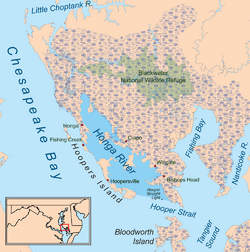Honga River facts for kids
Quick facts for kids Honga River |
|
|---|---|

Honga River Watershed
|
|
| Native name | Kahunge |
| Country | United States |
| State | Maryland |
| Region | Eastern Shore |
| Cities | Hoopersville, Bishops Head, Wingate, Crapo, Church Creek |
| Physical characteristics | |
| Main source | Church Creek, Maryland |
| River mouth | Chesapeake Bay Hooper's Island 0 ft (0 m) |
| Basin features | |
| Tributaries |
|
The Honga River is a special type of waterway called an estuary. An estuary is where a river meets the sea, mixing fresh water with salty ocean water. This river is on the eastern side of the Chesapeake Bay in Maryland, United States. It is bordered by Hoopers Island on the west and the mainland of Dorchester County, Maryland on the east. The Honga River is about 14 miles (22.5 km) long and over 1 mile (1.6 km) wide.
About the Honga River
The Honga River flows southeast towards the Hooper Strait. This strait is a narrow passage of water located north of Tangier Island. Several towns are found along the river's banks. These include Crapo, Fishing Creek, and Wingate.
More Than Just a River
The Honga River is actually the wider, southern part of a connected system of waterways. This system also includes Slaughter Creek, Upper Keene Broad, Dunnock Island Creek, and Lower Keene Broad. Think of it like a series of connected channels and wider areas that all flow together.
What's in a Name?
In the past, people sometimes called this river "tunger" or even "Hungary River." However, historians believe the name "Honga" comes from the Powhatan language. The word kahunge in Powhatan means "goose." This suggests that geese were likely common in the area long ago.
Fishing and Fun
The Honga River has a rich history, especially for fishing. It was once a very important place for catching oysters in the Chesapeake Bay. Today, it continues to be a popular spot for people who enjoy sport fishing.

